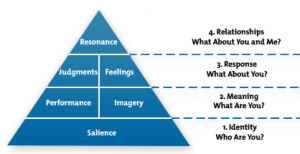This content has been archived. It may no longer be relevant
Last time I wrote about why consumers want brands and how bloomfield knoble can transfer that understanding into bottom-line impact, but that’s only one part of the overall branding process. This time I want to focus more on brand equity.
Before we define brand equity, we need to define brand. A brand is a set of perceptions and images that represent a company, product or service. Brand conveys the essence of what the firm’s product will deliver or what the consumer will experience as a result of purchasing the product. Once established, the brand provides the firm with value in the form of economic leverage an strategic advantage. The brand enables consumers to easily identify the firm’s offerings. Kevin Keller, author of Strategic Brand Management: Building, Measuring and Managing Brand Equity, defines brand equity as when consumers react more favorably to a product when it is marketed than when it is not.
At bloomfield knoble, we’re big believers in Keller’s framework:
You’ve probably seen this framework before – it’s fairly common now, but what it defines is “what do brands mean to customers?” It’s not what do you (as the marketer) want it to mean, but what does it mean to your customers? So brand equity is really about the impact you have on a consumer – what is their response to your marketing efforts? Brand equity affects consumer response to price, advertising, people, etc. Keller’s theory is that a customer’s perception of brand moves up the pyramid from the broadest base to the top point. The brand becomes more differentiated in the mind of the consumer as the consumer’s awareness moves up the pyramid. At the base of the pyramid is salience, or awareness of the brand; the next level up is product performance and brand imagery. Closer to the top of the pyramid are judgments and feelings as a response to the brand. Finally, the top of the pyramid is brand resonance, the ideal point where the consumer connects with the brand.
Consumers don’t view brand equity the same way. There are a number of different factors that create equity in the mind of the consumer:
Brand Loyalty | Brand loyalty is a measure of the connection that a customer has to a brand. From the customer’s perspective, brand loyalty can provide quality, reliability, service and other assurances. The customer who continues to purchase a brand even when competitors offer superior features has brand loyalty.
Brand Awareness | Brand awareness is related to the strength of the brand as reflected by the consumer’s ability to identify the brand under different conditions.
Brand Associations | Brand associations are anything linked in an individual’s memory to a brand. this includes images such as power, wealth, sophistication and identification with other users of the brand. These associations are powerful influences on the consumer’s decision to buy.
Perceived Quality | Perceived quality is the customer’s perception of the overall quality or superiority of a product or service with respect to its intended purpose, relative to alternatives. It is usually based on underlying characteristics of the product, including performance, features, reliability, durability, serviceability, style and design.
One of the elements that makes brand equity so valuable to us at bloomfield knoble is that brand equity is measurable. And because it’s measurable, it means that the efforts put into building brand equity can help determine return-on-investment and become an important part in the cycle of continuous success . . . but more on that next time.
Related articles
 The Importance of Branding to Your Hospitality Business
The Importance of Branding to Your Hospitality Business Building Your Brand: Proving and Differentiating Your Small Business
Building Your Brand: Proving and Differentiating Your Small Business Keller’s Brand Equity Model
Keller’s Brand Equity Model Does your brand vision tell your brand story?
Does your brand vision tell your brand story?


